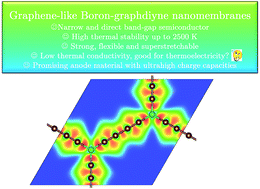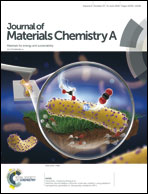Boron–graphdiyne: a superstretchable semiconductor with low thermal conductivity and ultrahigh capacity for Li, Na and Ca ion storage†
Abstract
Most recently, boron–graphdiyne, a π-conjugated two-dimensional (2D) structure made from a merely sp carbon skeleton connected with boron atoms was successfully experimentally realized through a bottom-up synthetic strategy. Motivated by this exciting experimental advance, we conducted density functional theory (DFT) and classical molecular dynamics simulations to study the mechanical, thermal conductivity and stability, electronic and optical properties of single-layer B-graphdiyne. We particularly analyzed the application of this novel 2D material as an anode for Li, Na, Mg and Ca ion storage. Uniaxial tensile simulation results reveal that B-graphdiyne owing to its porous structure and flexibility can yield superstretchability. The single-layer B-graphdiyne was found to exhibit a semiconducting electronic character, with a narrow band-gap of 1.15 eV based on the HSE06 prediction. It was confirmed that mechanical straining can be employed to further tune the optical absorbance and electronic band-gap of B-graphdiyne. Ab initio molecular dynamics results reveal that B-graphdiyne can withstand high temperatures, like 2500 K. The thermal conductivity of suspended single-layer B-graphdiyne was predicted to be very low, ∼2.5 W mK−1 at room temperature. Our first-principles results reveal the outstanding prospect of B-graphdiyne as an anode material with ultrahigh charge capacities of 808 mA h g−1, 5174 mA hg−1 and 3557 mA h g−1 for Na, Ca and Li ion storage, respectively. The comprehensive insight provided by this investigation highlights the outstanding physics of B-graphdiyne nanomembranes, and suggests them as highly promising candidates for the design of novel stretchable nanoelectronics and energy storage devices.



 Please wait while we load your content...
Please wait while we load your content...